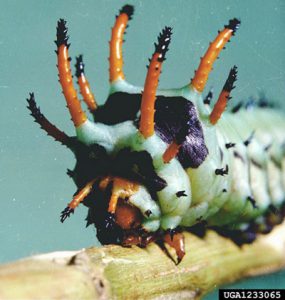The hickory horned devil is a blue-green colored caterpillar, about the size of a large hot dog, covered in long black thorns. They are often seen feeding on the leaves of deciduous forest trees, such as hickory, pecan, sweetgum, sumac and persimmon. For about 35 days, the hickory horned devil continuously eats, getting bigger and bigger every day. In late July to mid-August, they crawl down to the ground to search for a suitable location to burrow into the soil for pupation. While the hickory horned devil is fierce-looking, they are completely harmless. If you see one wandering through the grass or across the pavement, help it out by moving it to an open soil surface.
The pupa will overwinter until next May to early-June, at which time, they completely metamorphosize into a regal moth (Citheronia regalis). Like most other moths, it is nocturnal. But, this is a very large gray-green moth with orange wings, measuring up to 6 inches in width. It lives only about one week and never get to eat. In fact, they don’t even have a functional mouth. Adults mate during the second evening after emergence from the ground and begin laying eggs on tree leaves at dusk of the third evening. The adult moth dies of exhaustion. Eggs hatch in six to 10 days.
The regal moth, and its larvae stage called the hickory horned devil, is native to the southeastern United States. The damage they do to trees in minimal. Learning to appreciate this “odd” creature is something we can all do. For more information: https://edis.ifas.ufl.edu/pdffiles/IN/IN20900.pdf
- Sunshine in the Winter - December 20, 2024
- Helene’s Potential Impact on the Florida Coastal Wetlands - October 4, 2024
- April is Safe Digging Awareness Month - April 6, 2024


